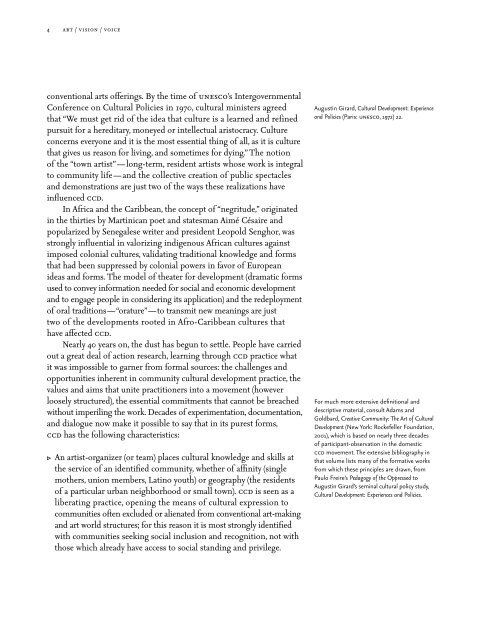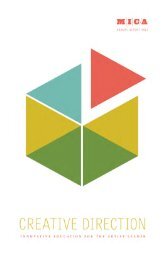art/vision/voice - Maryland Institute College of Art
art/vision/voice - Maryland Institute College of Art
art/vision/voice - Maryland Institute College of Art
Create successful ePaper yourself
Turn your PDF publications into a flip-book with our unique Google optimized e-Paper software.
4 <strong>art</strong> / <strong>vision</strong> / <strong>voice</strong><br />
conventional <strong>art</strong>s <strong>of</strong>ferings. By the time <strong>of</strong> unesco’s Intergovernmental<br />
Conference on Cultural Policies in 1970, cultural ministers agreed<br />
that “We must get rid <strong>of</strong> the idea that culture is a learned and refined<br />
pursuit for a hereditary, moneyed or intellectual aristocracy. Culture<br />
concerns everyone and it is the most essential thing <strong>of</strong> all, as it is culture<br />
that gives us reason for living, and sometimes for dying.” The notion<br />
<strong>of</strong> the “town <strong>art</strong>ist” — long-term, resident <strong>art</strong>ists whose work is integral<br />
to community life — and the collective creation <strong>of</strong> public spectacles<br />
and demonstrations are just two <strong>of</strong> the ways these realizations have<br />
influenced ccd.<br />
In Africa and the Caribbean, the concept <strong>of</strong> “negritude,” originated<br />
in the thirties by M<strong>art</strong>inican poet and statesman Aimé Césaire and<br />
popularized by Senegalese writer and president Leopold Senghor, was<br />
strongly influential in valorizing indigenous African cultures against<br />
imposed colonial cultures, validating traditional knowledge and forms<br />
that had been suppressed by colonial powers in favor <strong>of</strong> European<br />
ideas and forms. The model <strong>of</strong> theater for development (dramatic forms<br />
used to convey information needed for social and economic development<br />
and to engage people in considering its application) and the redeployment<br />
<strong>of</strong> oral traditions—“orature”—to transmit new meanings are just<br />
two <strong>of</strong> the developments rooted in Afro-Caribbean cultures that<br />
have affected ccd.<br />
Nearly 40 years on, the dust has begun to settle. People have carried<br />
out a great deal <strong>of</strong> action research, learning through ccd practice what<br />
it was impossible to garner from formal sources: the challenges and<br />
opportunities inherent in community cultural development practice, the<br />
values and aims that unite practitioners into a movement (however<br />
loosely structured), the essential commitments that cannot be breached<br />
without imperiling the work. Decades <strong>of</strong> experimentation, documentation,<br />
and dialogue now make it possible to say that in its purest forms,<br />
ccd has the following characteristics:<br />
v An <strong>art</strong>ist-organizer (or team) places cultural knowledge and skills at<br />
the service <strong>of</strong> an identified community, whether <strong>of</strong> affinity (single<br />
mothers, union members, Latino youth) or geography (the residents<br />
<strong>of</strong> a p<strong>art</strong>icular urban neighborhood or small town). ccd is seen as a<br />
liberating practice, opening the means <strong>of</strong> cultural expression to<br />
communities <strong>of</strong>ten excluded or alienated from conventional <strong>art</strong>-making<br />
and <strong>art</strong> world structures; for this reason it is most strongly identified<br />
with communities seeking social inclusion and recognition, not with<br />
those which already have access to social standing and privilege.<br />
Augustin Girard, Cultural Development: Experience<br />
and Policies (Paris: unesco, 1972) 22.<br />
For much more extensive definitional and<br />
descriptive material, consult Adams and<br />
Goldbard, Creative Community: The <strong>Art</strong> <strong>of</strong> Cultural<br />
Development (New York: Rockefeller Foundation,<br />
2001), which is based on nearly three decades<br />
<strong>of</strong> p<strong>art</strong>icipant-observation in the domestic<br />
ccd movement. The extensive bibliography in<br />
that volume lists many <strong>of</strong> the formative works<br />
from which these principles are drawn, from<br />
Paulo Freire’s Pedagogy <strong>of</strong> the Oppressed to<br />
Augustin Girard’s seminal cultural policy study,<br />
Cultural Development: Experiences and Policies.
















